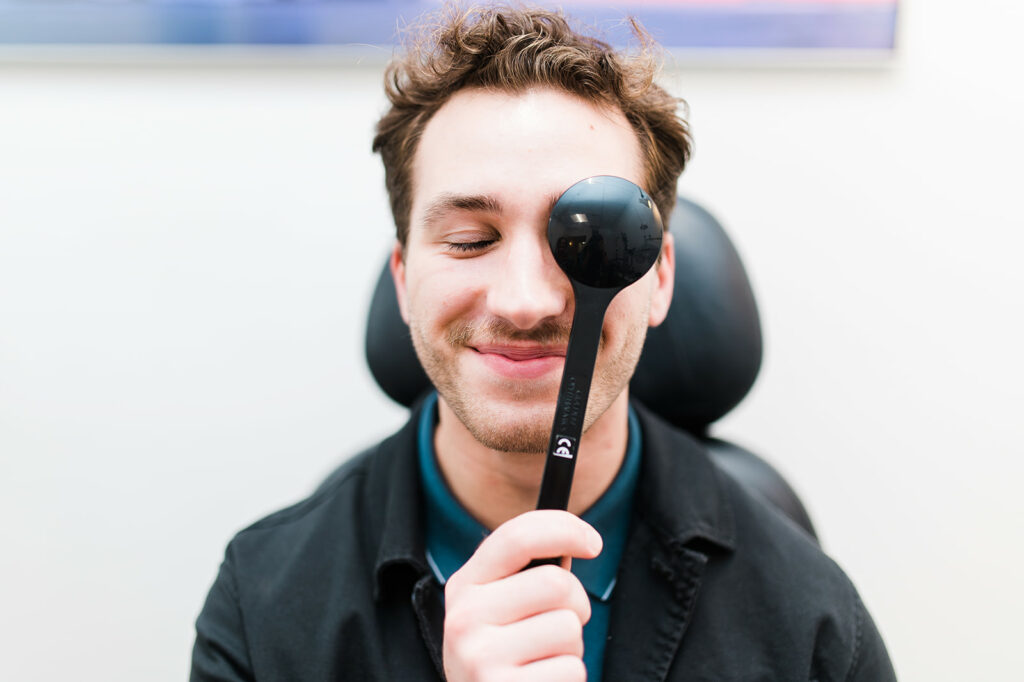Been putting off booking your next eye doctor appointment? Hey, you’re only human! Sometimes booking those regular health exams can fall by the wayside. And we get it—if it’s been a minute, it can be intimidating because you forget the process.
Plus, *gulp*, what if there’s bad news? To us, there’s no such thing. Regardless of that, it’s so important to book a routine eye test to maintain your eye health.
Worst case, we’ll be able to catch potential issues early on. Best case, we’ll commend you on your superior sight skills. Ultimately, it’s just like visiting your doctor and dentist—we want to make sure everything’s looking good!
If you’ve put off booking an appointment, we’re here for you. In this blog, we will ease tensions before your appointment by reminding you what happens at a regular eye test with your optometrist and what your eye doctor is looking for. We’re also sharing some common signs that clearly indicate that you should book your appointment sooner rather than later.
Want to skip to the good part? If you’re in Kamloops, book your eye doctor appointment now.
What Happens During an Eye Doctor Appointment?
As we mentioned above, the main reasons for an eye exam are to evaluate your vision and overall eye health, assess the clarity of vision and detect potential eye disorders. The eye test is typically conducted by an Optometrist (eye doctor) or Optometric Assistant.
When you visit Nicola Eye Care, our team makes it their top priority to make you feel comfortable from start to finish! Here’s an example step-by-step of how your eye exam could go when you visit our Kamloops clinic:
- Pre-Appointment: When booking your next appointment with an eye doctor, make sure you mention any vision problems you’re having. To prepare, here’s a checklist of things you should note and bring with you:
- Eye tests can range from 30 minutes to several hours
- Any questions you may have for the Optometrist
- A list of medications you’re currently taking
- Your family eye health history
- Glasses, contacts and prescription
- Sunglasses for the trip home in case your eyes are extra sensitive
- Welcome: From the moment you step through our eye clinic’s doors, we want to put you at ease! Check-in with one of our Optometric Assistants, fill out any necessary paperwork, and grab a complimentary (and might we add delicious) cup of coffee.
- Eye Health History: This is a way for us to gather all of the information we need about your general health and family eye health history. It also allows us to chat about any symptoms you’ve been experiencing. Getting all the details allows us to provide the best diagnosis. This information will be collected through a medical history questionnaire at the time of booking. The doctor requires an update each year to ensure you have a complete and updated eye health examination.

- Testing: Depending on how long it’s been since your last eye appointment, your exam could include some or all of the following tests.
- Visual Acuity: This is the standard eye test that you probably think of first. It typically involves reading letters and symbols from an eye chart. It allows your eye doctor to measure how well you can see from a variety of distances.
- Refraction: This test determines the exact prescription for corrective lenses (glasses or contact lenses) if needed. As you look through a device called a phoropter, your eye doctor will use different lenses to find the combination that provides the clearest vision.
- Eye Muscle Coordination: This test assesses how well your eye muscles work together.
- Peripheral Vision: This assesses your side (peripheral) vision and helps detect conditions that affect the outer areas of your visual field, like glaucoma.
- Intraocular Pressure Measurement: This test measures the pressure inside your eyes and is important for detecting glaucoma.
- Glaucoma testing is typically done either with a tonometer or tonopen to measure pressure. It can also be administered without contact using a puff of air.
- Slit Lamp: This microscope-like instrument allows the Optometrist to examine the front and back parts of your eyes in detail.
- Dilation: The eye doctor might administer eye drops to dilate (widen) the pupils for a more thorough examination of the back of the eyes.
- Keratography: A diagnostic imaging technique used to assess the cornea, which is the transparent front part of the eye covering the iris and the pupil. It is used to study the shape, curvature, and regularity of the cornea’s surface.
- Meibography: A diagnostic imaging technique used to visualize the meibomian glands and tear film break-up time. These glands are responsible for producing the oily part of the tear film that prevents tears from evaporating too quickly.
- Optomap: Optomap is a brand of retinal imaging technology that provides a wide-field view of the retina, enabling early detection and monitoring of eye conditions.
- Ishihara Color Vision: A type of screening method used to assess color vision deficiencies—particularly red-green colorblindness. These tests use a series of plates, each containing a pattern of coloured dots, numbers or shapes.
- Results: You can typically get your eye exam results right after your testing is done. Better yet, you can browse around the store and find a stylish new pair of glasses to get with your new prescription! If your results require more time, we’ll let you know and will help you schedule a follow-up eye doctor appointment.
- Post-Appointment: If your test included dilation, your vision might be slightly blurry and sensitive to light for several hours after. We recommend avoiding driving, reading and looking at screens for a few hours. Just to give your peepers a break!
And, now that you’ve successfully gone through the whole eye exam experience, don’t forget to book your next appointment! Setting a reminder in your phone or calendar is a good way to stay on top of it.
From start to finish, your Optometrist and Optometric Assistants will update you along the way and let you know what’s coming next to keep you as comfortable as possible. Have questions along the way? Don’t hesitate to ask! Think of something when you’re already at home? We’re always keen to help answer any questions you have.

6 Signs Indicating You Should Book Now
Outside of your regular eye exam routine, if you’re experiencing one or more of these symptoms, we recommend booking an eye appointment as soon as possible.
- Blurry Vision
- Frequent Headaches
- Difficulty Seeing at Night
- Squinting and/or Eye Fatigue
- Changes in Color Perception
- Flashes of Light or Floaters
We want to work with you to make sure your eyes are operating at their most optimal level! That all starts with an eye assessment to determine how to maintain your eye health.
Make Your Eye Exam Appointment
The eye doctor is in! We understand that life gets in the way and booking your eye appointments can be daunting, but we hope this blog helps relieve any tension.
Routine eye tests are essential to your general health and to help maintain your eye health. If there are any issues worth addressing, it’s important to catch them early and work with you to find the best plan of action. We’re always looking out for you—literally!
Convinced that you’re overdue for an eye exam? Our job here is done! Book your next eye appointment online and visit us at our Kamloops eye clinic. See you soon!